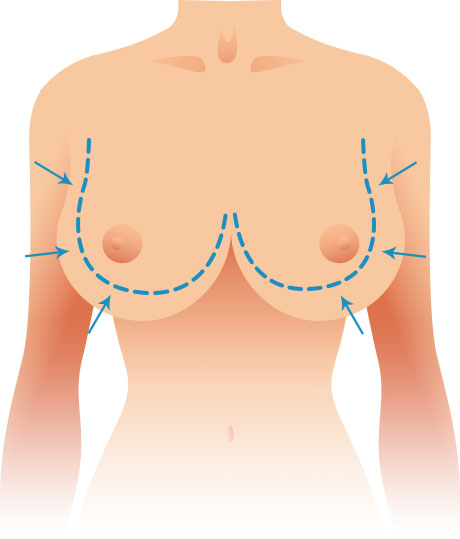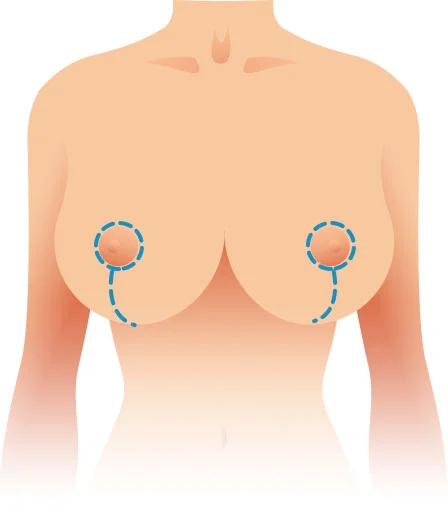The vast majority of women are far more concerned about their appearance and attractiveness when they are young and more… Read More
Breast Reduction
Home/Breast Surgery Procedures/Breast Reduction
Home/Breast Surgery Procedures/Breast Reduction
Breast reduction (also called reduction mammoplasty or reduction mammaplasty) is the plastic surgery procedure which reduces the size of overly large breasts to a more desirable smaller size. It involves the strategic removal of excess skin and breast tissue, resizing and repositioning of the nipple-areolar complexes (if needed), and lifting and reshaping of the breast tissue for a perkier, rejuvenated appearance.
When performed skillfully and safely by an experienced board-certified plastic surgeon, breast reduction surgery is a very effective and successful procedure. Many of our happiest patients are those who have undergone breast reduction. In his more than thirty years of medical practice in the Scottsdale and the Phoenix metropolitan area, Dr. Steven H. Turkeltaub has not encountered an individual who expressed regret for her decision to have the procedure performed. In fact, many of his patients have commented that if they had known years ago what they know now, that is, the dramatic change and improvement in the quality of their lives that breast reduction surgery could provide, they would have sought treatment long ago in order to have avoided the physical and mental issues that they had suffered from because of their enlarged breasts.
There is an extremely high satisfaction rate in women who have had a breast reduction. These patients find that this procedure resolves virtually all of their symptoms. In fact, women who have undergone breast reduction surgery are the happiest, most satisfied and most appreciative of our patients.
Due to social media policies, the following images have been censored. Please click on the button below to view the image.
At many levels, overly large breasts (macromastia) can be both physically and psychologically debilitating. They are frequently associated with pain and/or discomfort in the neck, shoulders and back, skin rashes and irritation, infections, and tender, undesirable grooving in the shoulders caused by pressure from bra straps. Women often face real difficulties and limitations in the type and extent of physical activities that they can engage in as a result of the associated discomfort and embarrassment. Trying to obtain bras that not only fit properly and comfortably but also provide the right amount of support and alleviation of discomfort can be a challenging task. Being able to find attractive, complementary and well-fitting clothes because of one’s disproportions is another real problematic area.
There are many reasons why a woman would want to seek a breast reduction. Listed below are several situations that may make one a candidate for the procedure:
An ancillary benefit of breast reduction surgery is that excess skin is removed and the breasts are contoured and raised to a more ideal position, thus simultaneously providing a breast lift. An instance where this would not be the case is if the breast reduction was exclusively performed via liposuction—a technique that is very rarely indicated due to its ability to solely remove fat and not glandular tissue or skin.
Insurance companies do provide coverage for breast reduction surgery though it is an exclusion in some policies. To determine whether you are eligible for coverage, you will need to carefully review your specific insurance policy. In the event that your plan does offer benefits, several criteria must be met in order to be approved for surgery with insurance coverage. These requirements will vary significantly among insurance providers and their particular policies. A few of these issues include:
If you have insurance coverage and specific benefits for breast reduction surgery, Dr. Turkeltaub’s staff will try to obtain pre-authorization for coverage of the surgery. However, if you are denied coverage for any reason, we do offer significantly discounted package pricing that may allow you to pursue your dreams of having breast reduction surgery.


Dr. Turkeltaub rarely uses drains in breast reduction surgery. However, when they are employed, they will typically be in place for around one week.
You can resume aerobic activities or sports at approximately three to four weeks though there are limitations of some activities for up to eight weeks. Most women can return to school or work within four to seven days.
The most common technique for performing breast reduction surgery involves an incision that extends from around the outer perimeter of the areola, then vertically down to the bottom of the breast and then horizontally along the inframammary crease—forming an inverted “T” or anchor shape. The final visibility of this scar will be greatly affected by one’s genetic makeup and natural healing response. More controllable elements that can also influence the ultimate appearance of breast reduction scarring include the plastic surgeon’s incision closure method, how closely postoperative instructions are followed and which scar care products or treatments are used.
In Dr. Turkeltaub’s experience, virtually all patients are very pleased with the physical and emotional impact of their breast reduction results and are quite satisfied with the resulting scarring. Additionally, most women find that any visible scarring can be concealed by the majority of blouses, bras and bikini tops they wish to wear.
The average cost of a breast reduction in the Phoenix area in March 2023 as reported by patients on the RealSelf.com website was $10,123*. That said, the price can range anywhere from $2,700 to as much as $20,000 or more. This broad price range is due to multiple components that impact the total expense of treatment. Some of the most notable elements that can affect what a patient pays for breast reduction include:
If you are considering having a breast reduction, Dr. Turkeltaub would be happy to meet with you for a consultation. After assessing your unique needs, he can formulate a personalized surgical approach and provide you with an itemized breakdown of all costs associated with your treatment plan.
A member of our team can also help you determine if your insurance plan will cover any portion of your procedure and/or introduce you to a variety of plastic surgery financing options if desired.
*This price range and average cost were taken from RealSelf—an online aesthetic care forum that gathers data based on reviews submitted by patients. It does not indicate the exact cost of breast reduction surgery at Dr. Turkeltaub’s practice. To obtain a personalized price quote, please contact us today to schedule a private consultation.
Assuming you are able to breastfeed prior to breast reduction surgery, there is a good possibility you will be able to do so after surgery though this would depend on a multitude of factors. With the free nipple graft technique where the nipple-areolar complex is totally removed as part of the procedure and then repositioned prior to completion of the operation, the ability to breastfeed is negated.
If you are planning to have kids in the future and wish to breastfeed, Dr. Turkeltaub recommends making this clear when you meet for your consultation. Since the risk of losing the ability to breastfeed does exist (as it does with most surgical breast procedures), disclosing this information from the start can result in improved treatment planning and a clearer idea of the appropriate timing for breast reduction surgery.
When surgery is performed by a board-certified plastic surgeon who is extensively trained, skilled and experienced in breast reduction, you are more likely to obtain far better results and with a much lower risk of complications (which are generally low). As with any surgical procedure, however, there can be complications and untoward outcomes so it is important to fully understand all aspects of a breast reduction prior to treatment.
Some potential risks and complications associated with breast reduction include:
Influencing these risks are a person’s general health, nutrition, habits and compliance in their care. For example, those who smoke (including marijuana), are markedly overweight, diabetic, have autoimmune diseases, or are in a suboptimal nutritional state such as due to certain dietary restrictions, have increased risks for postoperative problems.
With that being said, it bears repeating that the possibility of encountering complications and poor results is significantly reduced when breast reduction is performed by a highly trained, skilled and experienced board-certified plastic surgeon.
When determining candidacy for breast reduction, age is not as important as whether or not the breasts are fully (or almost fully) developed. In fact, breast reduction is not uncommonly performed on patients who are in their teens, assuming they have permission from a parent or guardian if they are under 18.
Generally speaking, though, breasts that are still growing should not be operated on because they might continue to grow after the procedure, potentially reaching a size and volume that requires a second breast reduction. As a result, Dr. Turkeltaub often advises postponing surgery until the breasts are fully matured.
It is important to understand that some degree of swelling may persist for as long as six months to a year following breast reduction. However, more notable swelling that might be present initially after breast reduction can often be reduced by:
While these general tips are beneficial for most patients, the best advice for reducing breast reduction swelling will ultimately be to strictly follow the personalized recommendations provided by Dr. Turkeltaub.
Once your surgical dressing is removed, usually at two to three days after surgery, you will be placed in a sports-type bra that is to be worn around the clock (except when showering) for approximately two to three weeks. After this time, you can either continue wearing this type of bra as you may desire or wear another type that is relatively supportive and comfortable but it does not need to be kept on at night.
Dr. Turkeltaub recommends wearing supportive bras as often as possible to help maintain the shape of the breasts and protect against the persistent pull of gravity over time.
No matter a woman’s breast size, there is never a 100% guarantee that she will be able to breastfeed following pregnancy. Some very large breasted women who you would think should be able to feed a village are unable to breastfeed whereas other women with very small breasts have no problems whatsoever breastfeeding. That being said, as long as the breast reduction technique that you are undergoing does not detach your nipple-areolar complex from the ductal and glandular system in your breasts (as in the free nipple graft technique), there is a high probability that you will be able to breastfeed.
Several of Dr. Turkeltaub’s breast reduction patients over the years have shared with him the fact that they were able to breastfeed their babies following pregnancy.
Just because you have health insurance doesn’t mean that it will pay for your breast reduction. You will need to specifically check your plan to make sure that this procedure is a covered benefit. There are many plans out there which exclude a breast reduction from coverage.
If you do have benefits you will then need to fulfill several specific criteria before being eligible for coverage. These criteria do vary considerably among plans. You may be able to find out what they are by calling your insurance company or checking on their website. We can assist you with this during and following your consultation and will try to get your surgery approved by your insurance company.
For additional helpful information on a variety of topics related to breast reduction, you can visit Dr. Turkeltaub’s Blog.
If you are troubled by excessively large breasts, there are numerous reasons to consider breast reduction surgery. Contact the Arizona Center for Aesthetic Plastic Surgery to discover how you can benefit from a breast reduction.